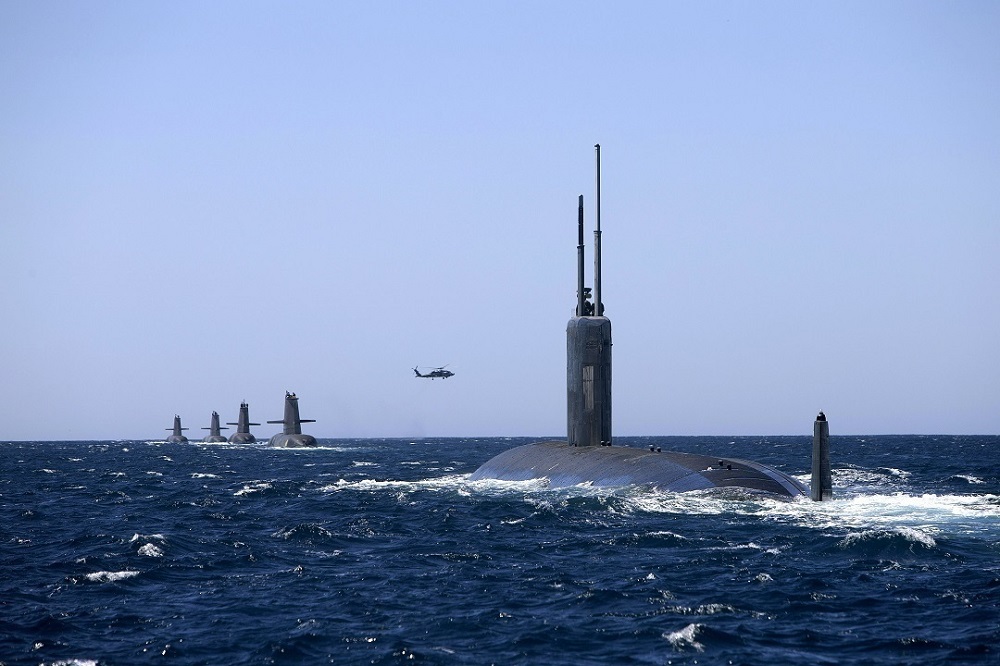
Australia hasn’t been truly sovereign in its own right since 1788. The head of state remains a foreign monarch. Generations of Australians have been lulled into forgetting this reality by the cultural familiarity of the Anglosphere. Australia only exists within a postwar rules-based order, and, conversely, without Pax Americana, Australia as we know it wouldn’t exist. Concerns about loss of sovereignty arising from AUKUS are illusionary. We’ve never really had it.
AUKUS requires a clear-eyed assessment of Australia’s sovereignty ambitions. Functioning sovereign states require the resources to defend their interests. Security analysts tend to express these capabilities mechanically, typically in terms of military force structures comprising ships, submarines, planes, tanks, infantry battalions, and so on. Capability gaps are identified in the acquisition, transitioning or sustainment of platforms. However, arguments for future force structure can’t be made in a vacuum. They must be cost conscious and restrained by the available human resources. In Australia’s case, the foremost future capability gaps will be in people, not machines.
The ANZUS Treaty singularly illustrates Australia’s strategic security team. Despite Donald Trump’s presidency forcing many Australians to confront for the first time a shocking cultural and values misfit with the leadership of their country’s major partner, the AUKUS agreement is emerging as the security guarantee to renew common interests of natural partners. Australia’s commitment cannot be understated. We have everything to play for in preserving enough of Pax Americana to maintain our concept of Australia within the rules-based order on which our economy and way of living depend.
The real risk to our strategic objectives is Australian demographics. We can’t expect a sovereign workforce enabling our strategic partnership commitments to emerge from within. The demographic trends demand an alternative. Australians are ageing and not attracted to defence careers. A declining percentage of Australia’s population will pass the fitness and security vetting for jobs in the Defence Department and other security agencies even if inclined to join. The 2023 review of Australia’s migration system reports that it is not fit for purpose and is enabling an expanding underclass of temporary workers. Divided loyalties are an increasingly vocal trend in Australia’s pluralist society. It is for others to quantify the AUKUS human resources bill, but put simply Australian demographics don’t support Defence’s workforce objectives.
In February, eminent naval strategist James Goldrick noted that if Australia is to embark on the AUKUS nuclear-powered submarine program, the bill in people must be understood and met from the outset. The commitment to AUKUS is not diminishing, and time is pressing to be innovative in finding the human resources to achieve AUKUS. The AUKUS SSN pathway statements set ambitious job-creation targets but lack detail on innovative ways to find the resources.
A new naval entity to achieve the maritime-security guarantee under AUKUS is a concept worth testing. Exploiting ambiguity in Australia’s sovereignty narrative is a compelling challenge to take us beyond unsustainable nationalism. AUKUS provides an opportunity for a fresh approach to collective security among nations with an interest in sustaining an open global trading system governed by markets and the rule of law. Partner nations would contribute resources, but the AUKUS SSN fleet could be controlled as a federated entity.
The strategic advantage offered by submarines is ambiguity. That advantage is multiplied by the size of the networked submarine fleet, the compelling opportunity of AUKUS. So, if the strategic guarantee offered by an AUKUS fleet is greater than the sum of the parts of the participant nations, would the partners be better served by a fleet of SSNs flying AUKUS flags?
An AUKUS fleet would potentially, and by necessity, illustrate efficiency and effectiveness outcomes over existing national navies. Operationalised by a franchise model with central command and control, an AUKUS fleet could be characterised by the collective objective of unrestricted oceans and the interoperability of fleet operations and sustainment. Its genesis should include specific consideration of the workforce and crewing requirements of each submarine.
The conceptual goal would be crews comprising a mix of partner nations. The nationality of the submarine command shouldn’t be fixed to specific submarines. Indeed, it may be an operational advantage for this aspect to be ambiguous to an adversary. Home basing of the submarines and their crews will require nuance and new ideas, but with the right incentives both can be inherently mobile.
The raise, train and sustain aspects of an AUKUS fleet workforce will demand careful attention, but it will provide opportunities over existing national stovepipes. Flexibility will be key and AUKUS partners will need to find ways to expand the partnership from a crewing perspective. Specifically, pathways for like-minded nations (Canada, New Zealand and others) to join the partnership must be envisaged.
The model for training must be driven by efficiency and managed to avoid duplication. Centres of excellence will be required to master the standards and develop curriculum for an AUKUS fleet. Training delivery could be franchised and centrally controlled in a similar but separate arrangement to operational command and control. The sustainment aspects of an AUKUS fleet workforce can only be speculated, but there should be no doubt that it will test the resolve of the partners.
AUKUS may provide Australia’s future security guarantee as part of a reinterpreted international communion of interests, but developing the resources to enable it will require a rebalancing of sovereignty ambitions to prioritise the common interests of the AUKUS partners.

